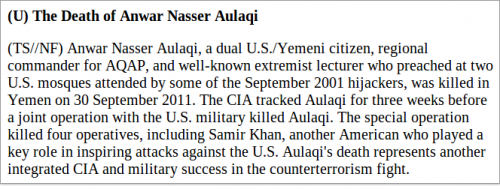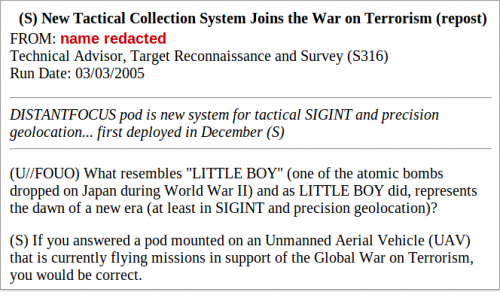| Online: | |
| Visits: | |
| Stories: |

| Story Views | |
| Now: | |
| Last Hour: | |
| Last 24 Hours: | |
| Total: | |
The NSA’s Secret Role in the U.S. Assassination Program – Part 2/2
From Part 1, above.
By Jeremy Scahill and Glenn Greenwald, The Intercept – February 10, 2014
http://tinyurl.com/ks3r4dd
One top-secret NSA document provided by Snowden is written by a SHENANIGANS operator who documents his March 2012 deployment to Oman, where the CIA has established a drone base. The operator describes how, from almost four miles in the air, he searched for communications devices believed to be used by Al Qaeda in the Arabian Peninsula in neighboring Yemen.The mission was code named VICTORYDANCE.
“The VICTORYDANCE mission was a great experience,” the operator writes. “It was truly a joint interagency effort between CIA and NSA. Flights and targets were coordinated with both CIAers and NSAers. The mission lasted 6 months, during which 43 flights were flown.”
VICTORYDANCE, he adds, “mapped the Wi-Fi fingerprint of nearly every major town in Yemen.”


The NSA has played an increasingly central role in drone killings over the past five years. In one top-secret NSA document from 2010, the head of the agency’s Strategic Planning and Policy Division of the Counterterrorism Mission Management Center recounts the history of the NSA’s involvement in Yemen. Shortly before President Obama took office, the document reveals, the agency began to “shift analytic resources to focus on Yemen.”
In 2008, the NSA had only three analysts dedicated to Al Qaeda in the Arabian Peninsula in Yemen. By the fall of 2009, it had 45 analysts, and the agency was producing “high quality” signal intelligence for the CIA and JSOC.
In December 2009, utilizing the NSA’s metadata collection programs, the Obama administration dramatically escalated U.S. drone and cruise missile strikes in Yemen.
The first strike in the country known to be authorized by Obama targeted an alleged Al Qaeda camp in the southern village of al-Majala.
The strike, which included the use of cluster bombs, resulted in the deaths of 14 women and 21 children. It is not clear whether the strike was based on metadata collection; the White House has never publicly explained the strike or the source of the faulty intelligence that led to the civilian fatalities.
Another top-secret NSA document confirms that the agency “played a key supporting role” in the drone strike in September 2011 that killed U.S. citizen Anwar al-Awlaki, as well as another American, Samir Khan. According to the 2013 Congressional Budget Justification, “The CIA tracked [Awlaki] for three weeks before a joint operation with the U.S. military killed” the two Americans in Yemen, along with two other people.
When Brandon Bryant left his Air Force squadron in April 2011, the unit was aiding JSOC in its hunt for the American-born cleric. The CIA took the lead in the hunt for Awlaki after JSOC tried and failed to kill him in the spring of 2011.
According to Bryant, the NSA’s expanded role in Yemen has only added to what he sees as the risk of fatal errors already evident in CIA operations. “They’re very non-discriminate with how they do things, as far as you can see their actions over in Pakistan and the devastation that they’ve had there,” Bryant says about the CIA. “It feels like they tried to bring those same tactics they used over in Pakistan down to Yemen. It’s a repeat of tactical thinking, instead of intelligent thinking.”
Those within the system understand that the government’s targeting tactics are fundamentally flawed. According to the former JSOC drone operator, instructors who oversee GILGAMESH training emphasize: “‘This isn’t a science. This is an art.’ It’s kind of a way of saying that it’s not perfect.”
Yet the tracking “pods” mounted on the bottom of drones have facilitated thousands of “capture or kill” operations in Afghanistan, Iraq, Yemen, Somalia and Pakistan since September 11. One top-secret NSA document provided by Snowden notes that by 2009, “for the first time in the history of the U.S. Air Force, more pilots were trained to fly drones … than conventional fighter aircraft,” leading to a “‘tipping point’ in U.S. military combat behavior in resorting to air strikes in areas of undeclared wars,” such as Yemen and Pakistan.
The document continues: “Did you ever think you would see the day when the U.S. would be conducting combat operations in a country equipped with nuclear weapons without a boot on the ground or a pilot in the air?”
Even NSA operatives seem to recognize how profoundly the agency’s tracking technology deviates from standard operating methods of war.
One NSA document from 2005 poses this question: “What resembles ‘LITTLE BOY’ (one of the atomic bombs dropped on Japan during World War II) and as LITTLE BOY did, represents the dawn of a new era (at least in SIGINT and precision geolocation)?”
Its reply: “If you answered a pod mounted on an Unmanned Aerial Vehicle (UAV) that is currently flying in support of the Global War on Terrorism, you would be correct.”
Another document boasts that geolocation technology has “cued and compressed numerous ‘kill chains’ (i.e. all of the steps taken to find, track, target, and engage the enemy), resulting in untold numbers of enemy killed and captured in Afghanistan as well as the saving of U.S. and Coalition lives.”
The former JSOC drone operator, however, remains highly disturbed by the unreliability of such methods. Like other whistleblowers, including Edward Snowden and Chelsea Manning, he says that his efforts to alert his superiors to the problems were brushed off. “The system continues to work because, like most things in the military, the people who use it trust it unconditionally,” he says.
When he would raise objections about intelligence that was “rushed” or “inaccurate” or “outright wrong,” he adds, “the most common response I would get was ‘JSOC wouldn’t spend millions and millions of dollars, and man hours, to go after someone if they weren’t certain that they were the right person.’ There is a saying at the NSA: ‘SIGINT never lies.’ It may be true that SIGINT never lies, but it’s subject to human error.”
The government’s assassination program is actually constructed, he adds, to avoid self-correction. “They make rushed decisions and are often wrong in their assessments. They jump to conclusions and there is no going back to correct mistakes.” Because there is an ever-increasing demand for more targets to be added to the kill list, he says, the mentality is “just keep feeding the beast.”
For Bryant, the killing of Awlaki – followed two weeks later by the killing of his 16-year-old son, Abdulrahman al Awlaki, also an American citizen – motivated him to speak out. Last October, Bryant appeared before a panel of experts at the United Nations – including the UN’s special rapporteur on human rights and counterterrorism, Ben Emmerson, who is currently conducting an investigation into civilians killed by drone strikes.
Dressed in hiking boots and brown cargo pants, Bryant called for “independent investigations” into the Obama administration’s drone program. “At the end of our pledge of allegiance, we say ‘with liberty and justice for all,’” he told the panel. “I believe that should be applied to not only American citizens, but everyone that we interact with as well, to put them on an equal level and to treat them with respect.”
Unlike those who oversee the drone program, Bryant also took personal responsibility for his actions in the killing of Awlaki. “I was a drone operator for six years, active duty for six years in the U.S. Air Force, and I was party to the violations of constitutional rights of an American citizen who should have been tried under a jury,” he said. “And because I violated that constitutional right, I became an enemy of the American people.”
Bryant later told The Intercept, “I had to get out because we were told that the president wanted Awlaki dead. And I wanted him dead. I was told that he was a traitor to our country…. I didn’t really understand that our Constitution covers people, American citizens, who have betrayed our country. They still deserve a trial.”
The killing of Awlaki and his son still haunt Bryant. The younger Awlaki, Abdulrahman, had run away from home to try to find his dad, whom he had not seen in three years. But his father was killed before Abdulrahman could locate him. Abdulrahman was then killed in a separate strike two weeks later as he ate dinner with his teenage cousin and some friends. The White House has never explained the strike.
“I don’t think there’s any day that goes by when I don’t think about those two, to be honest,” Bryant says. “The kid doesn’t seem like someone who would be a suicide bomber or want to die or something like that. He honestly seems like a kid who missed his dad and went there to go see his dad.”
Last May, President Obama acknowledged that “the necessary secrecy” involved in lethal strikes “can end up shielding our government from the public scrutiny that a troop deployment invites. It can also lead a president and his team to view drone strikes as a cure-all for terrorism.”
But that, says the former JSOC operator, is precisely what has happened. Given how much the government now relies on drone strikes – and given how many of those strikes are now dependent on metadata rather than human intelligence – the operator warns that political officials may view the geolocation program as more dependable than it really is.
“I don’t know whether or not President Obama would be comfortable approving the drone strikes if he knew the potential for mistakes that are there,” he says. “All he knows is what he’s told.”
Whether or not Obama is fully aware of the errors built into the program of targeted assassination, he and his top advisors have repeatedly made clear that the president himself directly oversees the drone operation and takes full responsibility for it. Obama once reportedly told his aides that it “turns out I’m really good at killing people.”
The president added, “Didn’t know that was gonna be a strong suit of mine.”
]]>
< 





